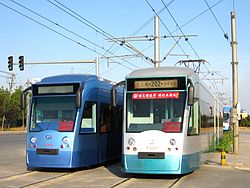- The TEDA tram opened in 2007 (closed in 2023)
- The Zhangjiang tram opened in 2010 (closed in 2023)
- Shenyang Modern Tram opened in 2013
- Nanjing Hexi Tram
- Huai'an Tram
- Chengdu Tram Line 2


Several cities in China had tram systems during the 20th century. By the end of the century, only Dalian and Changchun remained extant. [1] However the 21st century has seen a resurgence in tram transport systems as China attempts to combat with urban traffic congestion and pollution.







